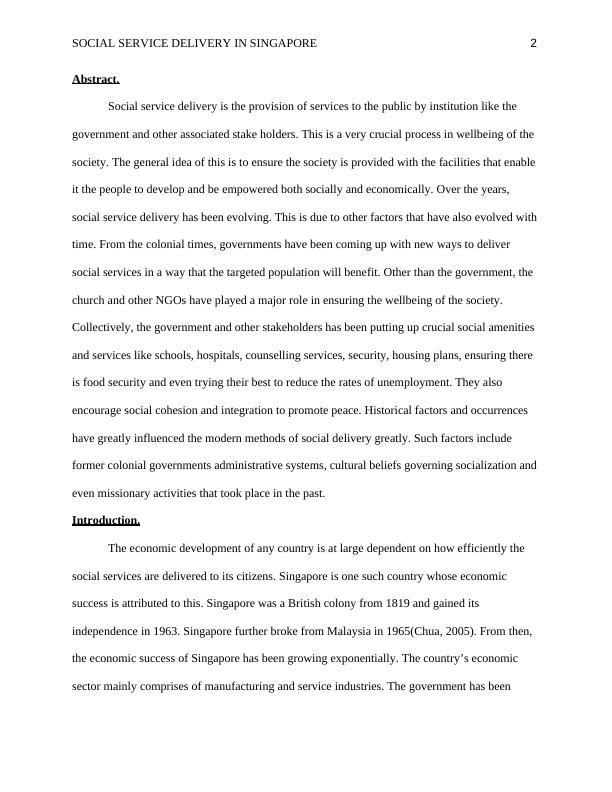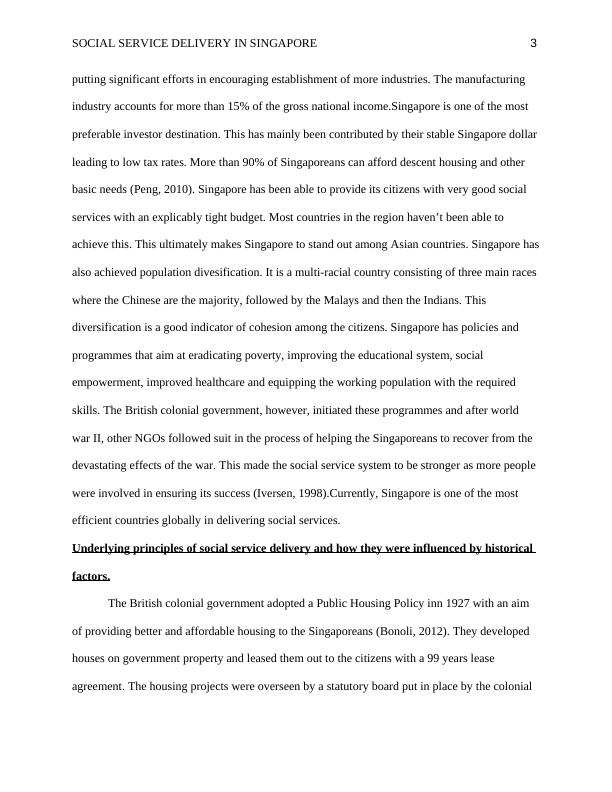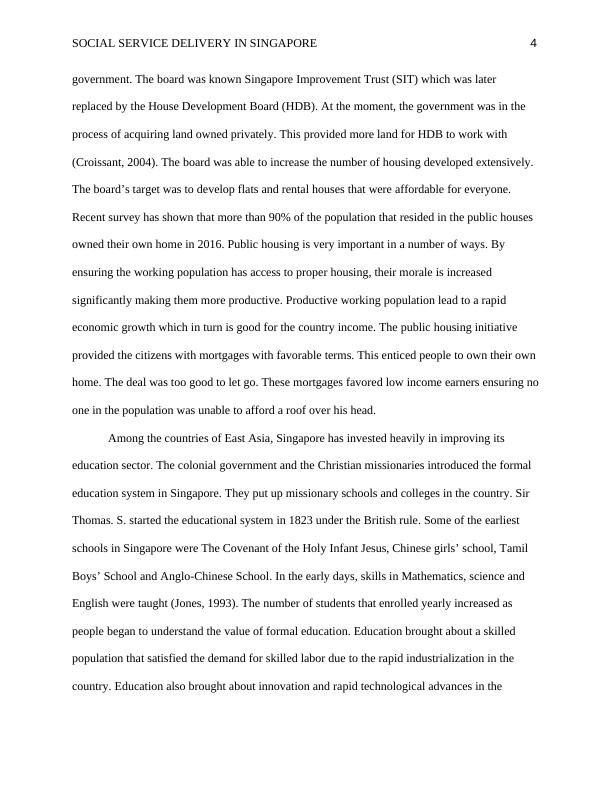Social Service Delivery in Singapore
Added on 2023-06-03
11 Pages3330 Words217 Views
SOCIAL SERVICE DELIVERY IN SINGAPORE 1
Social Service Delivery in Singapore
Name
Institution
Social Service Delivery in Singapore
Name
Institution

SOCIAL SERVICE DELIVERY IN SINGAPORE 2
Abstract.
Social service delivery is the provision of services to the public by institution like the
government and other associated stake holders. This is a very crucial process in wellbeing of the
society. The general idea of this is to ensure the society is provided with the facilities that enable
it the people to develop and be empowered both socially and economically. Over the years,
social service delivery has been evolving. This is due to other factors that have also evolved with
time. From the colonial times, governments have been coming up with new ways to deliver
social services in a way that the targeted population will benefit. Other than the government, the
church and other NGOs have played a major role in ensuring the wellbeing of the society.
Collectively, the government and other stakeholders has been putting up crucial social amenities
and services like schools, hospitals, counselling services, security, housing plans, ensuring there
is food security and even trying their best to reduce the rates of unemployment. They also
encourage social cohesion and integration to promote peace. Historical factors and occurrences
have greatly influenced the modern methods of social delivery greatly. Such factors include
former colonial governments administrative systems, cultural beliefs governing socialization and
even missionary activities that took place in the past.
Introduction.
The economic development of any country is at large dependent on how efficiently the
social services are delivered to its citizens. Singapore is one such country whose economic
success is attributed to this. Singapore was a British colony from 1819 and gained its
independence in 1963. Singapore further broke from Malaysia in 1965(Chua, 2005). From then,
the economic success of Singapore has been growing exponentially. The country’s economic
sector mainly comprises of manufacturing and service industries. The government has been
Abstract.
Social service delivery is the provision of services to the public by institution like the
government and other associated stake holders. This is a very crucial process in wellbeing of the
society. The general idea of this is to ensure the society is provided with the facilities that enable
it the people to develop and be empowered both socially and economically. Over the years,
social service delivery has been evolving. This is due to other factors that have also evolved with
time. From the colonial times, governments have been coming up with new ways to deliver
social services in a way that the targeted population will benefit. Other than the government, the
church and other NGOs have played a major role in ensuring the wellbeing of the society.
Collectively, the government and other stakeholders has been putting up crucial social amenities
and services like schools, hospitals, counselling services, security, housing plans, ensuring there
is food security and even trying their best to reduce the rates of unemployment. They also
encourage social cohesion and integration to promote peace. Historical factors and occurrences
have greatly influenced the modern methods of social delivery greatly. Such factors include
former colonial governments administrative systems, cultural beliefs governing socialization and
even missionary activities that took place in the past.
Introduction.
The economic development of any country is at large dependent on how efficiently the
social services are delivered to its citizens. Singapore is one such country whose economic
success is attributed to this. Singapore was a British colony from 1819 and gained its
independence in 1963. Singapore further broke from Malaysia in 1965(Chua, 2005). From then,
the economic success of Singapore has been growing exponentially. The country’s economic
sector mainly comprises of manufacturing and service industries. The government has been

SOCIAL SERVICE DELIVERY IN SINGAPORE 3
putting significant efforts in encouraging establishment of more industries. The manufacturing
industry accounts for more than 15% of the gross national income.Singapore is one of the most
preferable investor destination. This has mainly been contributed by their stable Singapore dollar
leading to low tax rates. More than 90% of Singaporeans can afford descent housing and other
basic needs (Peng, 2010). Singapore has been able to provide its citizens with very good social
services with an explicably tight budget. Most countries in the region haven’t been able to
achieve this. This ultimately makes Singapore to stand out among Asian countries. Singapore has
also achieved population divesification. It is a multi-racial country consisting of three main races
where the Chinese are the majority, followed by the Malays and then the Indians. This
diversification is a good indicator of cohesion among the citizens. Singapore has policies and
programmes that aim at eradicating poverty, improving the educational system, social
empowerment, improved healthcare and equipping the working population with the required
skills. The British colonial government, however, initiated these programmes and after world
war II, other NGOs followed suit in the process of helping the Singaporeans to recover from the
devastating effects of the war. This made the social service system to be stronger as more people
were involved in ensuring its success (Iversen, 1998).Currently, Singapore is one of the most
efficient countries globally in delivering social services.
Underlying principles of social service delivery and how they were influenced by historical
factors.
The British colonial government adopted a Public Housing Policy inn 1927 with an aim
of providing better and affordable housing to the Singaporeans (Bonoli, 2012). They developed
houses on government property and leased them out to the citizens with a 99 years lease
agreement. The housing projects were overseen by a statutory board put in place by the colonial
putting significant efforts in encouraging establishment of more industries. The manufacturing
industry accounts for more than 15% of the gross national income.Singapore is one of the most
preferable investor destination. This has mainly been contributed by their stable Singapore dollar
leading to low tax rates. More than 90% of Singaporeans can afford descent housing and other
basic needs (Peng, 2010). Singapore has been able to provide its citizens with very good social
services with an explicably tight budget. Most countries in the region haven’t been able to
achieve this. This ultimately makes Singapore to stand out among Asian countries. Singapore has
also achieved population divesification. It is a multi-racial country consisting of three main races
where the Chinese are the majority, followed by the Malays and then the Indians. This
diversification is a good indicator of cohesion among the citizens. Singapore has policies and
programmes that aim at eradicating poverty, improving the educational system, social
empowerment, improved healthcare and equipping the working population with the required
skills. The British colonial government, however, initiated these programmes and after world
war II, other NGOs followed suit in the process of helping the Singaporeans to recover from the
devastating effects of the war. This made the social service system to be stronger as more people
were involved in ensuring its success (Iversen, 1998).Currently, Singapore is one of the most
efficient countries globally in delivering social services.
Underlying principles of social service delivery and how they were influenced by historical
factors.
The British colonial government adopted a Public Housing Policy inn 1927 with an aim
of providing better and affordable housing to the Singaporeans (Bonoli, 2012). They developed
houses on government property and leased them out to the citizens with a 99 years lease
agreement. The housing projects were overseen by a statutory board put in place by the colonial

SOCIAL SERVICE DELIVERY IN SINGAPORE 4
government. The board was known Singapore Improvement Trust (SIT) which was later
replaced by the House Development Board (HDB). At the moment, the government was in the
process of acquiring land owned privately. This provided more land for HDB to work with
(Croissant, 2004). The board was able to increase the number of housing developed extensively.
The board’s target was to develop flats and rental houses that were affordable for everyone.
Recent survey has shown that more than 90% of the population that resided in the public houses
owned their own home in 2016. Public housing is very important in a number of ways. By
ensuring the working population has access to proper housing, their morale is increased
significantly making them more productive. Productive working population lead to a rapid
economic growth which in turn is good for the country income. The public housing initiative
provided the citizens with mortgages with favorable terms. This enticed people to own their own
home. The deal was too good to let go. These mortgages favored low income earners ensuring no
one in the population was unable to afford a roof over his head.
Among the countries of East Asia, Singapore has invested heavily in improving its
education sector. The colonial government and the Christian missionaries introduced the formal
education system in Singapore. They put up missionary schools and colleges in the country. Sir
Thomas. S. started the educational system in 1823 under the British rule. Some of the earliest
schools in Singapore were The Covenant of the Holy Infant Jesus, Chinese girls’ school, Tamil
Boys’ School and Anglo-Chinese School. In the early days, skills in Mathematics, science and
English were taught (Jones, 1993). The number of students that enrolled yearly increased as
people began to understand the value of formal education. Education brought about a skilled
population that satisfied the demand for skilled labor due to the rapid industrialization in the
country. Education also brought about innovation and rapid technological advances in the
government. The board was known Singapore Improvement Trust (SIT) which was later
replaced by the House Development Board (HDB). At the moment, the government was in the
process of acquiring land owned privately. This provided more land for HDB to work with
(Croissant, 2004). The board was able to increase the number of housing developed extensively.
The board’s target was to develop flats and rental houses that were affordable for everyone.
Recent survey has shown that more than 90% of the population that resided in the public houses
owned their own home in 2016. Public housing is very important in a number of ways. By
ensuring the working population has access to proper housing, their morale is increased
significantly making them more productive. Productive working population lead to a rapid
economic growth which in turn is good for the country income. The public housing initiative
provided the citizens with mortgages with favorable terms. This enticed people to own their own
home. The deal was too good to let go. These mortgages favored low income earners ensuring no
one in the population was unable to afford a roof over his head.
Among the countries of East Asia, Singapore has invested heavily in improving its
education sector. The colonial government and the Christian missionaries introduced the formal
education system in Singapore. They put up missionary schools and colleges in the country. Sir
Thomas. S. started the educational system in 1823 under the British rule. Some of the earliest
schools in Singapore were The Covenant of the Holy Infant Jesus, Chinese girls’ school, Tamil
Boys’ School and Anglo-Chinese School. In the early days, skills in Mathematics, science and
English were taught (Jones, 1993). The number of students that enrolled yearly increased as
people began to understand the value of formal education. Education brought about a skilled
population that satisfied the demand for skilled labor due to the rapid industrialization in the
country. Education also brought about innovation and rapid technological advances in the

End of preview
Want to access all the pages? Upload your documents or become a member.
Related Documents
ECONOMICS Name of Studentlg...
|18
|4590
|15
Role of Women Under British Colonieslg...
|7
|1452
|15
Urban and Regional Planning: Comparative Planninglg...
|12
|2100
|158
Healthcare for The Aboriginal and Torres Strait Islander Peoplelg...
|8
|2027
|360
About Colonialism and Canadalg...
|5
|1045
|11
Welfare Law for Mentally Ill - Importance and Implementationlg...
|8
|1883
|315
